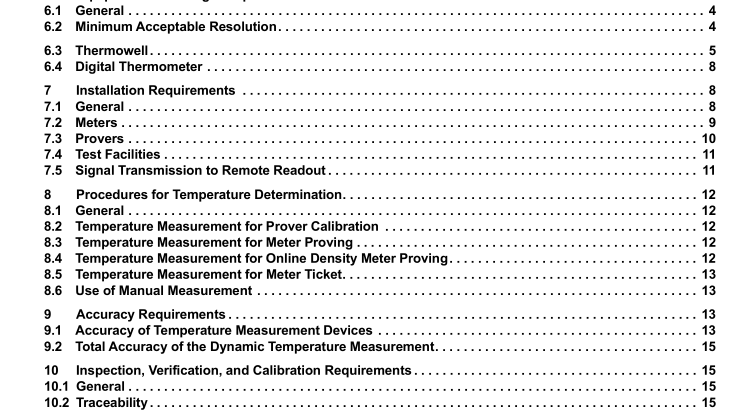API MPMS 7.4:2018 pdf free download.Manual of Petroleum Measurement Standards Chapter 7—Temperature Determination Section 4—Dynamic Temperature Measurement
6.3.3 Pressure Rating
The thermowell selected shall comply with design codes for the operating pressures and temperatures of the system.
6.3.4 Installation The thermowell should be selected to conform to code and user installation practices. Thermowells are typically threaded, welded, or flange mounted. The immersion length of the thermowell should be sufficient to put the sensing portion of the device within the center one-third of the pipe diameter or provide immersion of 0.3 m (1 ft.) unless limited by fluid velocity considerations. The thermowell should be installed in as near to a vertical position as practical to allow it to be filled with an appropriate thermal-conducting material to cover the sensor.
6.3.5 Material The thermowell should be constructed of a material that is compatible with the liquid material that the thermowell is exposed to and should provide a degree of corrosion resistance for all surfaces. Usually Type 304 or 316 stainless steel is specified.
6.3.6 Thermowell Conductive Material In the case where the temperature sensor does not come into contact with the thermowell wall, the space between the sensor and the thermowell wall shall be filled with an appropriate amount of non-freezing thermal-conducting material to improve heat conduction between the wall of the thermowell and the sensor, and to improve the temperature sensor response time.
6.3.7 Electrical Temperature Sensor and Transmitter
6.3.7.1 Temperature Sensors Electronic temperature devices for dynamic measurement are usually housed in metal probes that mount into thermowells. The probes are generally tip sensitive. Therefore, the probes must be securely seated in the bottom of the thermowell for optimum temperature transfer. Spring loaded or adjustable length probes are recommended. If the probe cannot be seated in the bottom of the thermowell, an appropriate thermal-conducting material shall be used between the temperature sensor and the thermowell wall. The wiring to the probe is critical because of the low signal levels of the devices. These devices should be installed as recommended by the manufacturer for best accuracy. The equipment and transducers should be installed in accordance with all API and NFPA National Electrical Code (NEC) hazardous area specifications.
6.3.7.2 Resistance Temperature Detector A resistance temperature detector (RTD) is a sensor with an electrical resistance that is a function of temperature.
The RTD is usually a small coil of platinum (or copper wire) and when used with appropriate circuits will provide temperature signals to readouts and other equipment. The RTD may be a resistance wire wound on a supporting nonconductive core, a thin film type, or other type. The element should be properly encased in a protective enclosure (probe), typically constructed of stainless steel.
The electronic circuits should be intrinsically safe as required. The length of the temperature sensitive portion of a single- point (spot) element should not exceed 100 mm (4 in.). Three-wire or four-wire RTDs are recommended to compensate for lead length resistance. Refer to ASTM E1137 for material and fabrication specifications and ASTM E644 for manufacturer calibration and testing of RTDs.
Class A RTDs are recommended for accurate temperature measurement such as custody transfer. For such applications, accuracy may be improved by reducing the span of the transmitting device to under 40 °C (100 °F) from the manufacturer wide operating range where appropriate.
6.3.7.3 Thermistor Thermistors may be used as an alternative to the resistance temperature device for digital thermometers, but are not used as commonly as an in-line temperature sensor. Given the small size of the semiconductor used in the sensing portion of a thermistor, the temperature sensor will usually have a very quick response. With a suitable choice of the semiconductor, linearity of response can be obtained over a wide range of temperatures. Some drift may be experienced with thermistors, and errors can arise from auto-heating of the semiconductor. Adjustment facilities are therefore usually incorporated in thermistor-based digital thermometers. Thermistors are often not stable and accurate enough for custody transfer purposes.
6.3.7.4 Other Types of Electrical Temperature Sensors Other types of temperature sensors (e.g. thermocouples, semiconductors, etc.) are also available and may be suitable for custody transfer purposes, provided that they meet the performance requirements in this standard.
6.3.8 Temperature Transmitter With and Without Temperature Sensor
6.3.8.1 General A temperature transmitter is a device that converts a signal from a temperature sensor into a form suitable for propagating the temperature data by the sensor from the site of measurement to the location where the data will be displayed and used. Transmitters may be located remotely from the sensor or directly attached as a single assembly.API MPMS 7.4 pdf download.API MPMS 7.4:2018 pdf free download
